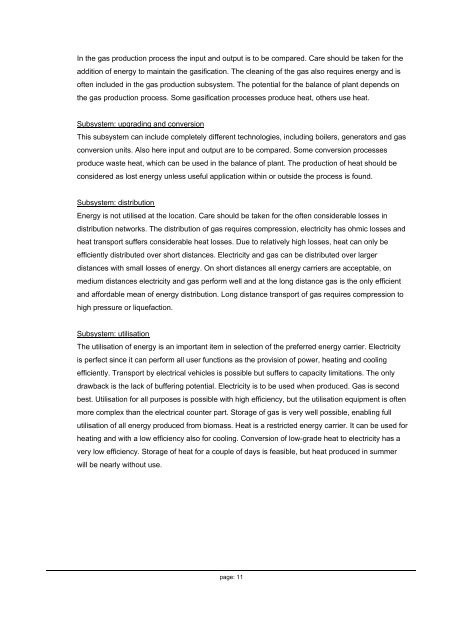Adding gas from biomass to the gas grid - SGC
Adding gas from biomass to the gas grid - SGC
Adding gas from biomass to the gas grid - SGC
- No tags were found...
Create successful ePaper yourself
Turn your PDF publications into a flip-book with our unique Google optimized e-Paper software.
In <strong>the</strong> <strong>gas</strong> production process <strong>the</strong> input and output is <strong>to</strong> be compared. Care should be taken for <strong>the</strong>addition of energy <strong>to</strong> maintain <strong>the</strong> <strong>gas</strong>ification. The cleaning of <strong>the</strong> <strong>gas</strong> also requires energy and isoften included in <strong>the</strong> <strong>gas</strong> production subsystem. The potential for <strong>the</strong> balance of plant depends on<strong>the</strong> <strong>gas</strong> production process. Some <strong>gas</strong>ification processes produce heat, o<strong>the</strong>rs use heat.Subsystem: upgrading and conversionThis subsystem can include completely different technologies, including boilers, genera<strong>to</strong>rs and <strong>gas</strong>conversion units. Also here input and output are <strong>to</strong> be compared. Some conversion processesproduce waste heat, which can be used in <strong>the</strong> balance of plant. The production of heat should beconsidered as lost energy unless useful application within or outside <strong>the</strong> process is found.Subsystem: distributionEnergy is not utilised at <strong>the</strong> location. Care should be taken for <strong>the</strong> often considerable losses indistribution networks. The distribution of <strong>gas</strong> requires compression, electricity has ohmic losses andheat transport suffers considerable heat losses. Due <strong>to</strong> relatively high losses, heat can only beefficiently distributed over short distances. Electricity and <strong>gas</strong> can be distributed over largerdistances with small losses of energy. On short distances all energy carriers are acceptable, onmedium distances electricity and <strong>gas</strong> perform well and at <strong>the</strong> long distance <strong>gas</strong> is <strong>the</strong> only efficientand affordable mean of energy distribution. Long distance transport of <strong>gas</strong> requires compression <strong>to</strong>high pressure or liquefaction.Subsystem: utilisationThe utilisation of energy is an important item in selection of <strong>the</strong> preferred energy carrier. Electricityis perfect since it can perform all user functions as <strong>the</strong> provision of power, heating and coolingefficiently. Transport by electrical vehicles is possible but suffers <strong>to</strong> capacity limitations. The onlydrawback is <strong>the</strong> lack of buffering potential. Electricity is <strong>to</strong> be used when produced. Gas is secondbest. Utilisation for all purposes is possible with high efficiency, but <strong>the</strong> utilisation equipment is oftenmore complex than <strong>the</strong> electrical counter part. S<strong>to</strong>rage of <strong>gas</strong> is very well possible, enabling fullutilisation of all energy produced <strong>from</strong> <strong>biomass</strong>. Heat is a restricted energy carrier. It can be used forheating and with a low efficiency also for cooling. Conversion of low-grade heat <strong>to</strong> electricity has avery low efficiency. S<strong>to</strong>rage of heat for a couple of days is feasible, but heat produced in summerwill be nearly without use.page: 11
















